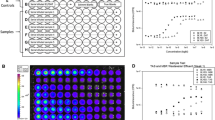Abstract
Bioluminescent yeast assays BLYES and BLYAS are whole-cell bioassays that utilize genetically modified Saccharomyces cerevisiae bioreporters to detect estrogenic and androgenic activities, respectively. The bioreporter strains chromosomally express human estrogen receptor alpha (BLYES) or androgen receptor (BLYAS) and contain a reporter plasmid expressing the complete bacterial luciferase gene cassette (luxCDABE) under the control of an estrogen- or androgen-responsive promoter. Exposure to endocrine-disrupting compounds activates the receptor which subsequently turns on the expression of the reporter genes, resulting in dose-dependent bioluminescence (i.e., light) emission. These yeast whole-cell bioassays provide rapid, cost-effective, and high-throughput detection of endocrine-disrupting activities in environmental samples. This protocol will provide a detailed description of the standard assay procedures as well as a framework for data analysis.
Access this chapter
Tax calculation will be finalised at checkout
Purchases are for personal use only
Similar content being viewed by others
References
Vogel J (2004) Tunnel vision: the regulation of endocrine disruptors. Pol Sci 37(3):277–303
Kabir ER, Rahman MS, Rahman I (2015) A review on endocrine disruptors and their possible impacts on human health. Environ Toxicol Pharmacol 40(1):241–258. https://doi.org/10.1016/j.etap.2015.06.009
Sanseverino J, Gupta RK, Layton AC, Patterson SS, Ripp SA, Saidak L, Simpson ML, Schultz TW, Sayler GS (2005) Use of Saccharomyces cerevisiae BLYES expressing bacterial bioluminescence for rapid, sensitive detection of estrogenic compounds. Appl Environ Microbiol 71(8):4455–4460. https://doi.org/10.1128/AEM.71.8.4455-4460.2005
Eldridge M, Sanseverino J, Layton A, Easter J, Schultz T, Sayler G (2007) Saccharomyces cerevisiae BLYAS, a new bioluminescent bioreporter for detection of androgenic compounds. Appl Environ Microbiol 73(19):6012–6018
Gupta RK, Patterson SS, Ripp SA, Sayler GS (2003) Expression of the Photorhabdus luminescens lux genes (luxA, B, C, D, and E) in Saccharomyces cerevisiae. FEMS Yeast Res 4(3):305–313
Sanseverino J, Eldridge ML, Layton AC, Easter JP, Yarbrough J, Schultz TW, Sayler GS (2009) Screening of potentially hormonally active chemicals using bioluminescent yeast bioreporters. Toxicol Sci 107(1):122–134. https://doi.org/10.1093/toxsci/kfn229
Krifaton C, Kriszt B, Risa A, Szoboszlay S, Cserháti M, Harkai P, Eldridge M, Wang J, Kukolya J (2013) Application of a yeast estrogen reporter system for screening zearalenone degrading microbes. J Hazard Mater 244:429–435. https://doi.org/10.1016/j.jhazmat.2012.11.063
Osimitz T, Eldridge M, Sloter E, Welsh W, Ai N, Sayler G, Menn F, Toole C (2012) Lack of androgenicity and estrogenicity of the three monomers used in Eastman’s Tritan copolyesters. Food Chem Toxicol 50(6):2196–2205
Balazs A, Krifaton C, Risa A, Cserhati M, Kukolya J, Toth A, Hahn J, Szoboszlay S, Eldridge M, Wang J, Kriszt B (2014) Biodegradation of 5 alpha-dihydrotestosterone to non-androgenic products. Int Biodeterior Biodegradation 93:162–167. https://doi.org/10.1016/j.ibiod.2014.05.008
Bergamasco AMD, Eldridge M, Sanseverino J, Sodre FF, Montagner CC, Pescara IC, Jardim WF, Umbuzeiro GD (2011) Bioluminescent yeast estrogen assay (BLYES) as a sensitive tool to monitor surface and drinking water for estrogenicity. J Environ Monit 13(11):3288–3293. https://doi.org/10.1039/c1em10464k
Jardim W, Montagner C, Pescara I, Umbuzeiro G, Bergamasco A, Eldridge M, Sodre F (2012) An integrated approach to evaluate emerging contaminants in drinking water. Sep Purif Technol 84:3–8. https://doi.org/10.1016/j.seppur.2011.06.020
Ruan T, Liang D, Song SJ, Song MY, Wang HL, Jiang GB (2015) Evaluation of the in vitro estrogenicity of emerging bisphenol analogs and their respective estrogenic contributions in municipal sewage sludge in China. Chemosphere 124:150–155. https://doi.org/10.1016/j.chemosphere.2014.12.017
Wang J, Eldridge M, Menn FM, Dykes T, Sayler G (2015) Standardized application of yeast bioluminescent reporters as endocrine disruptor screen for comparative analysis of wastewater effluents from membrane bioreactor and traditional activated sludge. Ecotoxicology 24(10):2088–2099. https://doi.org/10.1007/s10646-015-1556-z
Acknowledgments
Research funding was provided by the National Institute of Food and Agriculture, US Department of Agriculture, under award number 2015-33610-23598 and the US National Science Foundation, Chemical, Bioengineering, Environmental and Transport Systems (CBET) program, under award number 1530953.
Author information
Authors and Affiliations
Corresponding author
Editor information
Editors and Affiliations
Rights and permissions
Copyright information
© 2020 Springer Science+Business Media, LLC, part of Springer Nature
About this protocol
Cite this protocol
Xu, T., Young, A., Narula, J., Sayler, G., Ripp, S. (2020). High-Throughput Analysis of Endocrine-Disrupting Compounds Using BLYES and BLYAS Bioluminescent Yeast Bioassays. In: Ripp, S. (eds) Bioluminescent Imaging. Methods in Molecular Biology, vol 2081. Humana, New York, NY. https://doi.org/10.1007/978-1-4939-9940-8_3
Download citation
DOI: https://doi.org/10.1007/978-1-4939-9940-8_3
Published:
Publisher Name: Humana, New York, NY
Print ISBN: 978-1-4939-9939-2
Online ISBN: 978-1-4939-9940-8
eBook Packages: Springer Protocols




